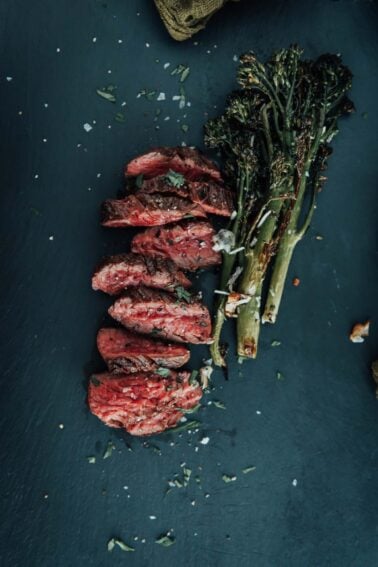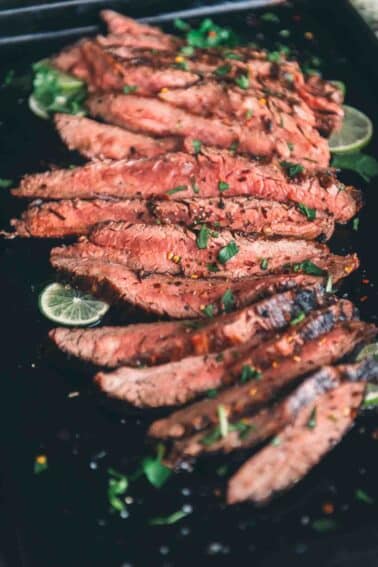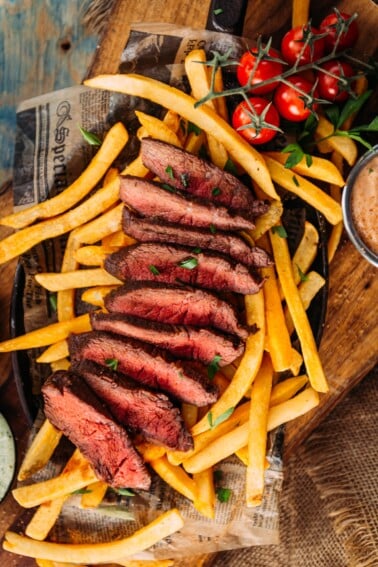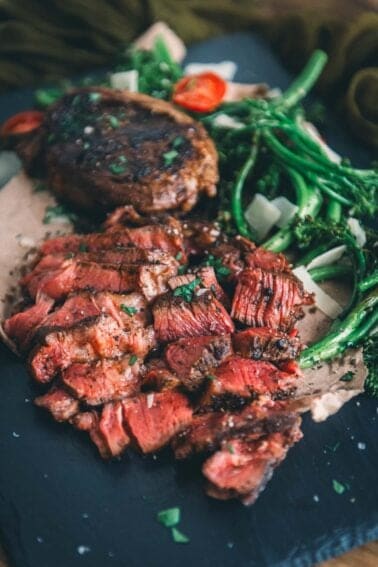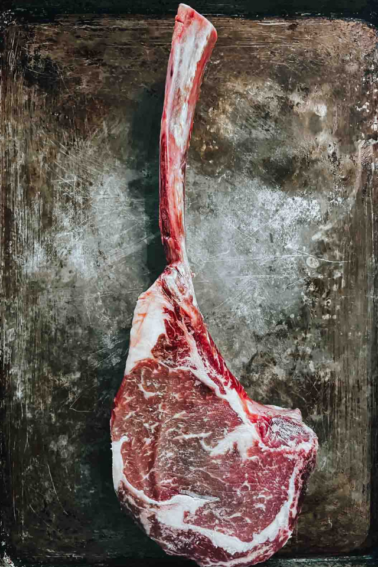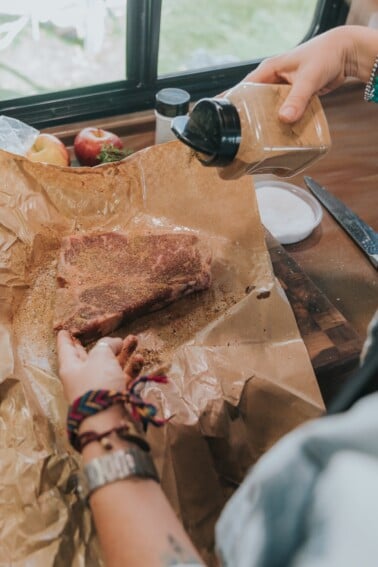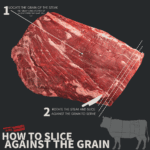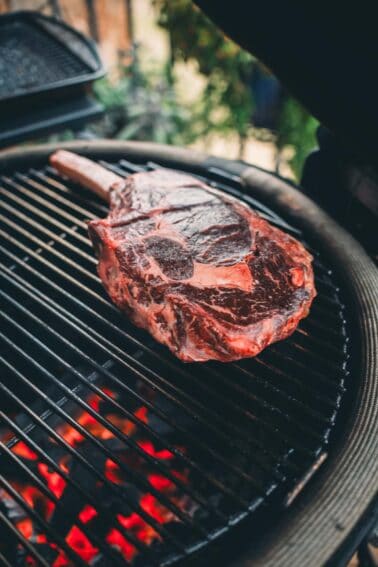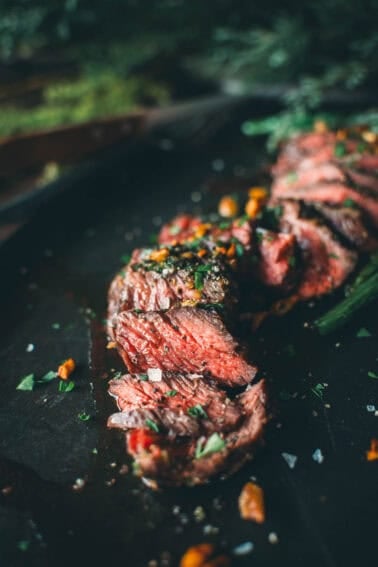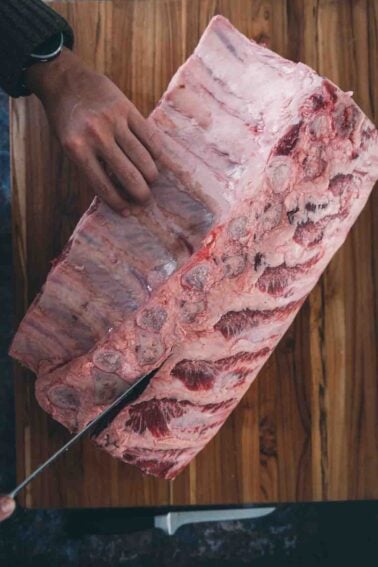If you’re craving tender, juicy slices of meat, cooking it perfectly is only one step to getting the best bite. The next step is slicing the meat so that it’s easy to chew. That’s what it means when you hear about slicing against the grain.
The grain is the natural fibers, the long, parallel lines running through your steak, pork, venison, poultry, or lamb. Although we’re mainly focusing on beef for this guide, learning how to cut against the grain works to improve all types of meat.

Table of Contents
- Tl;DR Summary
- What is Meant by Cutting Meat Against the Grain?
- How Cutting Against the Grain Breaks Up the Tough Fibers
- Why Cut Against the Grain?
- 🤓 A note for Meat Nerds:
- 🔪 Step-by-Step Guide: How to Cut Meat Against the Grain Recipe
- 🥩 Recipes that Benefit from Cutting Meat Against the Grain
- Common Mistakes to Avoid when Cutting Against the Grain
- Alternative Cuts for Tender Meat
- Taking It to the Next Level: Advanced Techniques
- More helpful Meat Guides
Tl;DR Summary
Cutting meat against the grain involves slicing it perpendicular to its muscle fibers. Cutting against the grain is a technique that enhances tenderness and taste.
- Cut Perpendicular to Fibers: Enhances tenderness by shortening muscle fibers.
- Thin Slices: Maximizes tenderness and flavor absorption.
- Technique Matters: Identify and cut perpendicular to the grain.
- Tools Needed: Sharp knife and stable cutting board.
- Common Mistakes: Avoid cutting parallel to the grain and using a dull knife.
- What to cut: Ideal for grilled steaks, seared cuts, and any meat.
- Advanced Tips: Marinate or brine for additional tenderness and flavor.
What is Meant by Cutting Meat Against the Grain?
Cutting against the grain means slicing perpendicular to these lines rather than parallel. It’s a small adjustment in technique that can make a big difference in your recipes.
Now, why does it matter? Well, cutting against the grain is like a secret trick for tenderness. When you cut against the grain, you’re shortening those long muscle fibers, making each bite more tender and easier to chew. Basically, you’re creating bite-sized pieces that practically melt in your mouth for almost any type of steak.
Although the grade of beef, marbling, cooking method, and internal temperature and marbling also play a factor in the tender pieces of meat, knowing how to cut a steak against the grain is the key to making sure all your hard work pays off.
So, you’re ready to master the art of cutting against the grain? Here’s a sneak peek into the steps:
- Identify the Grain: Take a close look at your meat. You’ll notice the direction of the grain running in one direction. That’s the path you want to go against.
- Slice Perpendicular: Armed with this knowledge, position your knife perpendicular to the grain of the meat. If the lines run from left to right, your knife should move up and down.
- Thin Slices: Start cutting thin slices against the grain. The thinner, the better for tenderness and flavor absorption.
- Repeat as Needed: Depending on the cut of meat and your desired serving size, repeat this process until you’ve sliced enough to enjoy the entire piece.
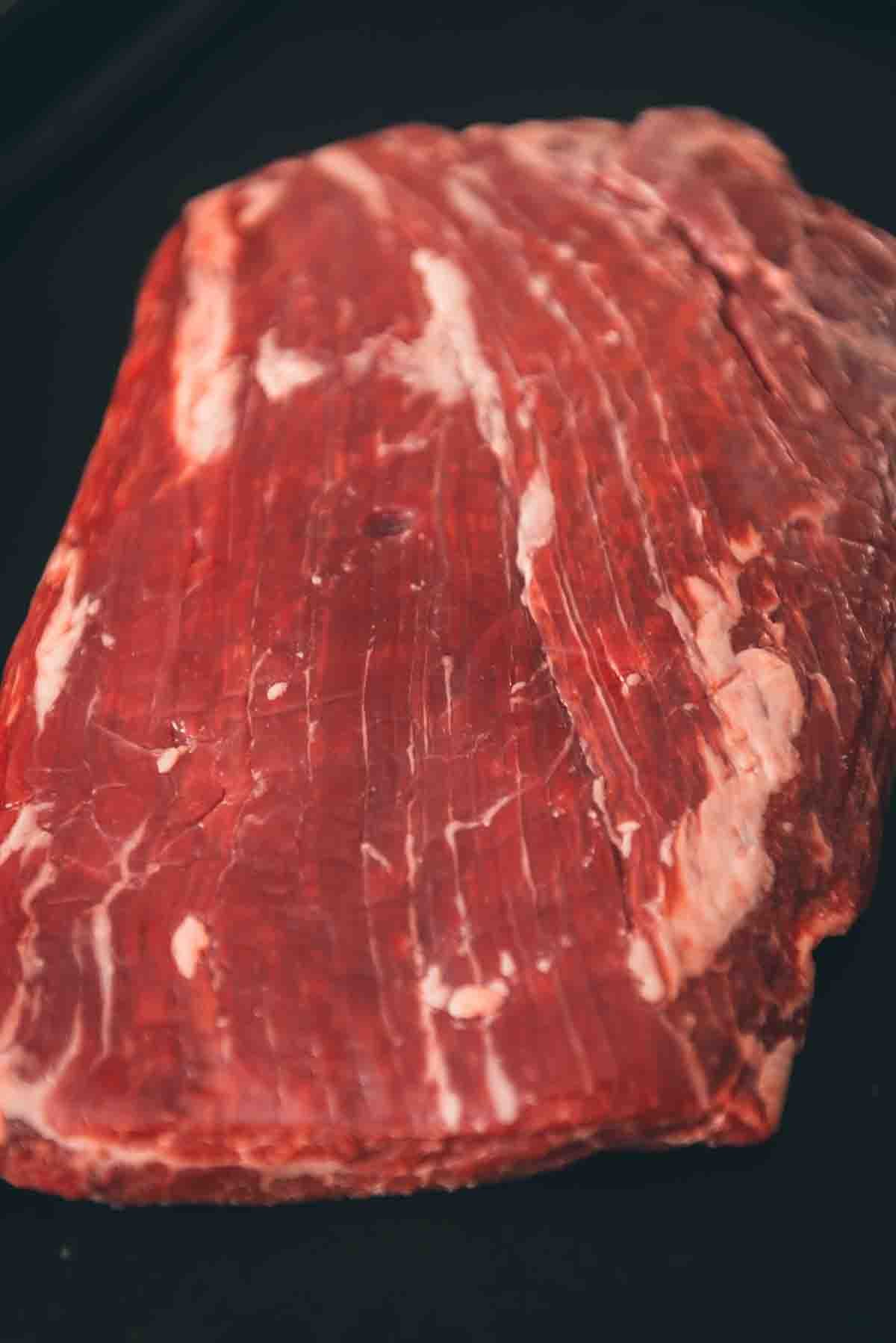
What is the grain of meat?
When we talk about the grain in meat, we’re referring to the direction of the muscle fibers within the cut. It’s the natural pattern or lines running through a piece of meat, much like wood grain in a piece of lumber.
Understanding the grain is important because of how it affects the texture and tenderness of the meat. The grain is a pattern that’s the structure of the muscle fibers. And, knowing how to navigate it is crucial for achieving the best results when cutting and cooking meat.
Muscle Fibers and Their Impact on Texture
Muscle fibers are like the building blocks of meat, and their arrangement contributes to the overall texture of the cut. Long fibers, often found in tougher cuts like flank or skirt steak, create a more fibrous and chewy texture. On the other hand, tender cuts of meat, like filet mignon have shorter, finer fibers, resulting in a more delicate and melt-in-your-mouth experience.
The length and arrangement of these muscle fibers play a significant role in determining the mouthfeel of the meat. And that can be helped by how you cut it.

How Cutting Against the Grain Breaks Up the Tough Fibers
Think of the long muscle fibers as strands in a rubber band. When you cut parallel to these fibers, you essentially keep the strands intact, resulting in a chewier texture.
However, when you cut against the grain, you’re slicing through those fibers, breaking them into smaller, more manageable pieces. It’s like cutting the rubber band into smaller pieces. This simple adjustment in the cutting technique makes chewing easier.
Why Cut Against the Grain?
Cutting against the grain is a game-changer for tenderizing your meat. Because you’re shortening the long meat fibers, or the grain, that run parallel to each other, you’re making it easier to chew the meat. This makes each bite more tender because you’re slicing through the bundles of muscle fibers instead of along them. It’s like making your meat naturally more bite-friendly.
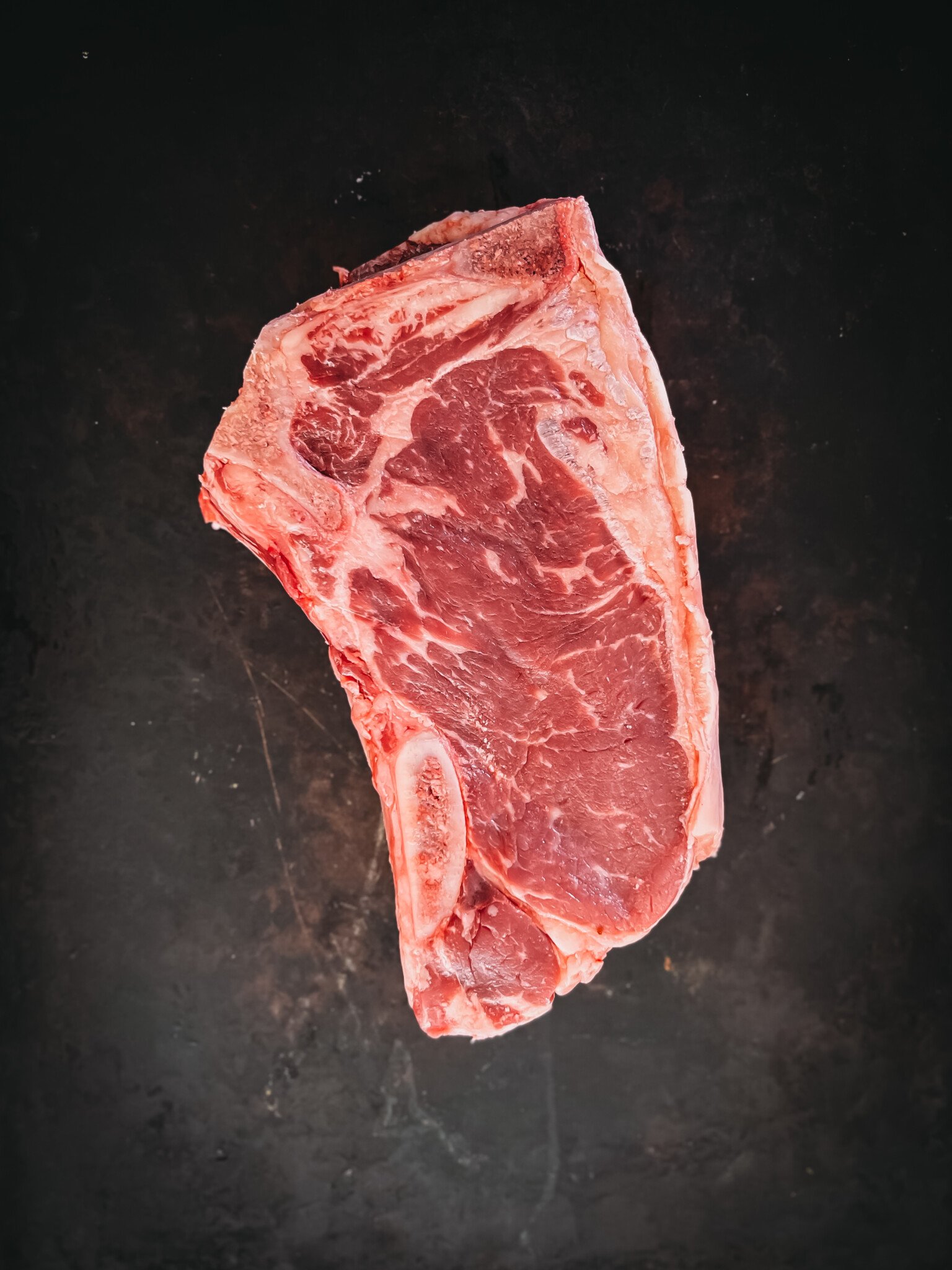
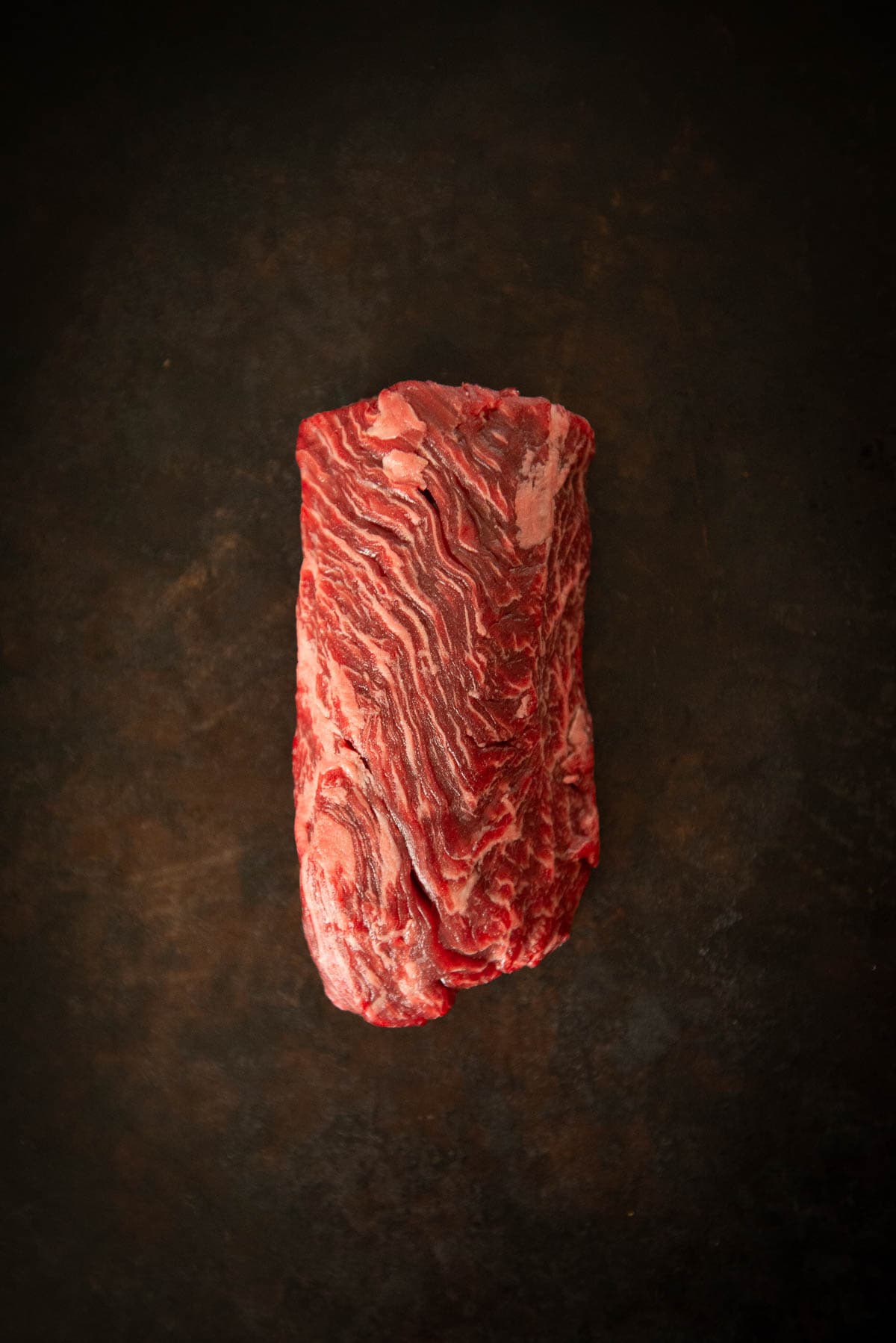
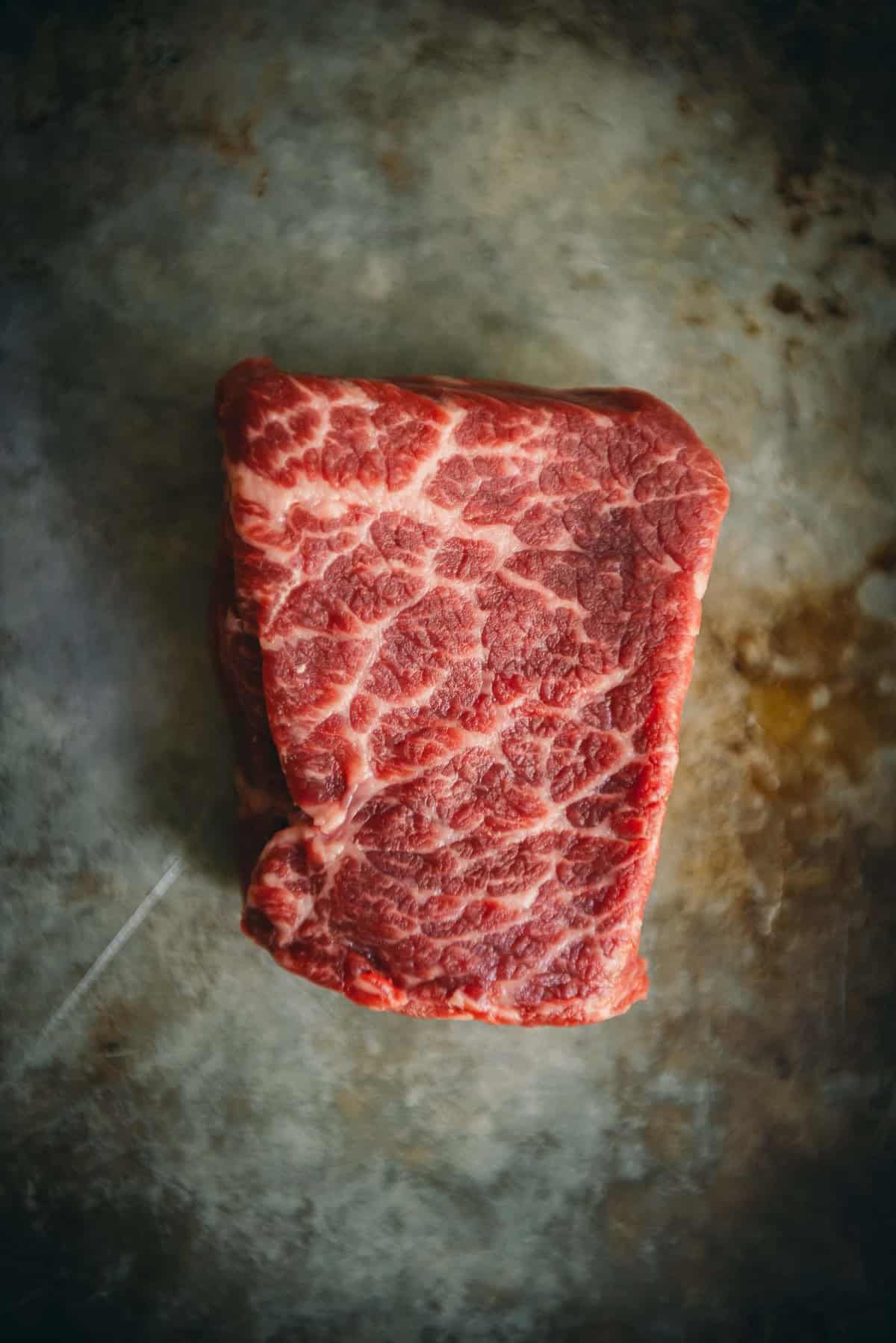
How to Determine the Grain in Meat
- Examine the Meat: Look for visible lines or streaks on the surface, indicating the direction of the muscle fibers. Remember, this works for all the different cuts of meat.
- Analyze Cut-Specific Patterns: Different cuts may exhibit unique grain patterns, such as the long fibers in skirt or hanger steak.
- Observe Muscle Fiber Bundles: Pay attention to the bundles forming the grain structure, influencing tenderness.
Recognizing Grain Direction: Visual Cues and Texture Differences
- Visual Inspection: Observe lines on the meat’s surface, offering initial cues about the grain direction. Sometimes, the connective tissue and grain are easier to spot in raw meat before it’s been cooked.
- Feel the Texture: Run your fingers over the meat to sense differences in texture along and across the grain.
- Consider Slice Thickness and Width: Thicker slices along the grain may be chewier, while thinner slices against the grain offer tenderness.
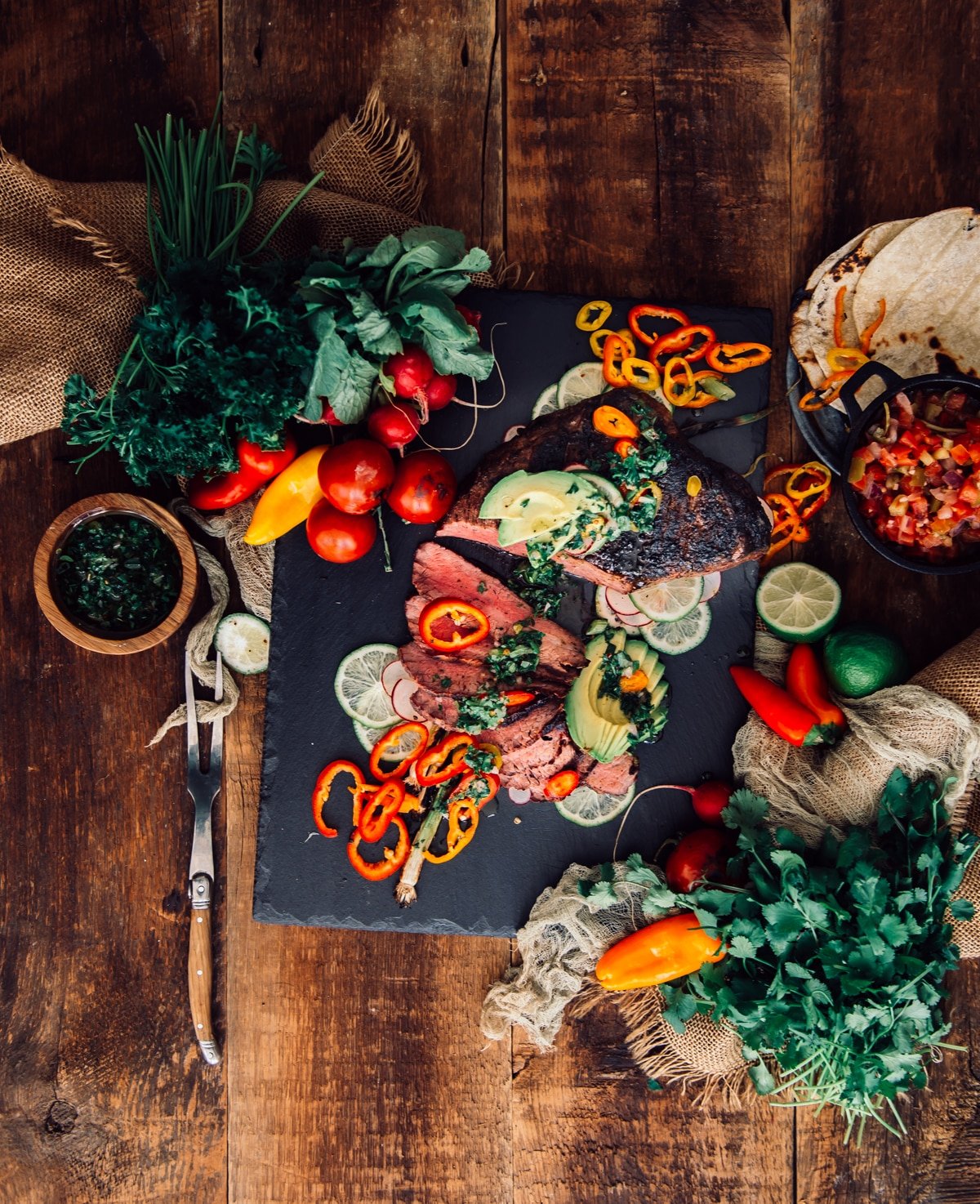
🤓 A note for Meat Nerds:
Most cuts of steak are easy to find the grain, but there are a few that can be a little tricky.
- A whole tri-tip actually has two grains that run in different directions. To slice it, it’s best to make the first cut in the middle of the roast, where the grain comes together, and then slice each portion against the grain.
- The same goes for a whole brisket. The point and the flat have different directions of grain, so it’s important to make the first slice where they come together and then cut accordingly.
🔪 Step-by-Step Guide: How to Cut Meat Against the Grain
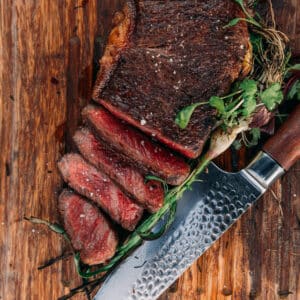
Recommended Equipment
- Chef's knife Ensures clean and precise cuts.
- cutting board Provides a stable surface for slicing.
Ingredients
- Meat: Whether it’s steak, poultry, pork, or any cut of your choice, start with a quality piece.
Instructions
Identify the Grain:
- Examine the meat to determine the direction of the muscle fibers or grain pattern.
Orientation:
- Place the meat on the cutting board with the grain running parallel to the edge for optimal slicing.
Slice
- Using a sharp knife, slice the meat, across the grain, into thin even strips.
Notes
Tips for Slicing Against the Grain
- Maintain a 90-degree Angle: Hold the knife at a right angle to the grain for precise and consistent cuts.
- Thickness of the Slice: Adjust the thickness according to your preference, but thinner slices often enhance tenderness.
- Length of the Meat Fibers: Analyze the length of the muscle fibers when determining slice width to optimize tenderness.
- Consistent Technique: Apply the same cutting technique throughout the meat for uniform results. Avoid moving the knife back and forth, ‘sawing’ through the meat. Try to slice in one clean motion.
- Wood Grain Analogy: Visualize the concept by comparing it to cutting along the wood grain to understand the perpendicular slicing technique.
- Always slice your meat after you have let it rest to help the meat stay juicy.
Bookmark this recipe now!

🥩 Recipes that Benefit from Cutting Meat Against the Grain
(hint, all cuts of beef benefit from being sliced the right way)
Steak Recipes
Pan-Seared Hanger Steak Recipe
Beef Recipes
Grilled Flank Steak
Beef Recipes
Pan-Seared Tri-Tip Steaks
Beef Recipes
Sous Vide Flat Iron Steak
Beef Recipes
The Best Way to Cook a Chuck Steak
Common Mistakes to Avoid when Cutting Against the Grain
- Cutting with the grain: Cutting with the grain defeats the purpose of the technique, making for tough chewy bites. It doesn’t shorten the muscle fibers, which means the meat won’t be as tender. Always identify the grain direction and cut against the grain to achieve the desired tenderness.
- Using a dull knife: A dull knife can tear and shred the meat rather than cleanly slicing through it. This not only affects the texture of the meat but also makes the cutting process more difficult and unsafe. A sharp knife ensures clean cuts that will slice through the meat with little resistance, maintaining the integrity of the muscle fibers and enhancing tenderness.
- Cutting unevenly: Uneven cuts can lead to variations in tenderness and flavor absorption. Some parts may be more tender, while others might remain chewy. To ensure a consistent and enjoyable eating experience, focus on making uniform, thin slices against the grain throughout the entire piece of meat.
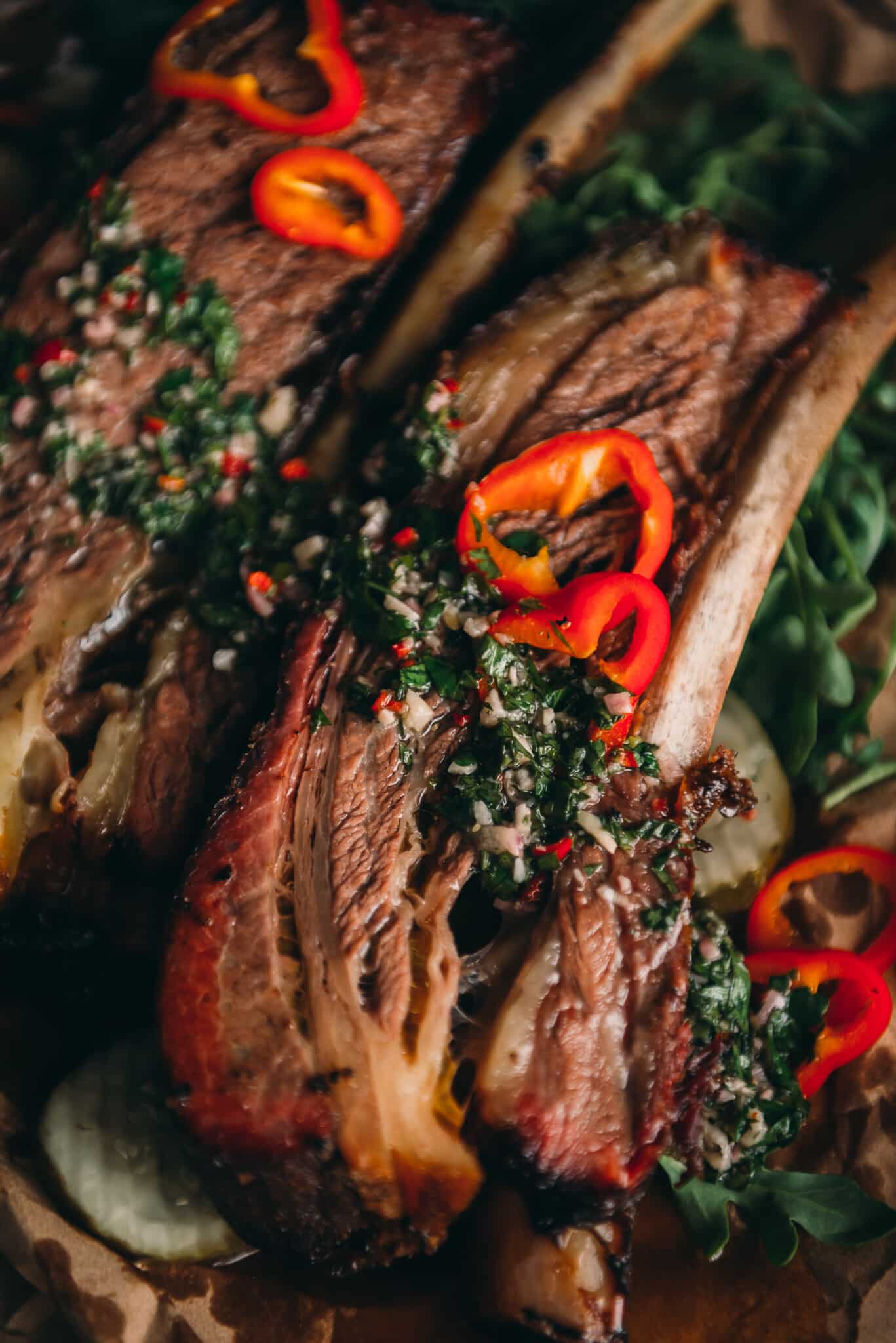
Alternative Cuts for Tender Meat
Tender meat isn’t just about the usual suspects like beef tenderloin or other cuts known for their natural tenderness. Cooking inherently tender cuts is a breeze, and there’s a variety of recipes to enhance their natural flavors. This Sous Vide Filet Mignon recipe submerges the steak in temperature-controlled water to maintain tenderness and flavor. You just need to make sure to watch the steak temperature for juicy bites.
Try exploring alternative cuts that bring tenderness to the table right from the start. Some examples are lean cuts of beef, or rich flat iron steak, or hanger steak. These options can offer affordability or a richer beefy flavor, that when sliced properly, can offer a better eating experience. And there are even ‘tough cuts,’ like braised beef shank, that when cooked properly and sliced correctly, can become a mouth-watering tender bite.
On the other hand, his Grilled Hanger Steak and Grilled Flat Iron Steak are seared quickly over high heat to maintain tenderness.
Taking It to the Next Level: Advanced Techniques
Advanced Ways to Further Improve Tenderness Through Marinating and Brining
- When you’re ready to elevate your meat game, experiment with advanced marinating and brining techniques. For example, marinating flank steak in a flank steak marinade not only imparts taste but also tenderizes by breaking down connective tissues. Opt for ingredients like citrus, vinegar, or enzymatic fruits for an extra tender touch.
- You can wet brine meat or dry brine for more tenderness and flavor. Submerging your piece of meat in a saltwater solution infuses moisture, enhancing tenderness and flavor. These advanced methods ensure your steak not only tastes incredible but achieves the perfect sear you get from the Maillard reaction.
- Experiment with various seasoning and flavoring methods to discover your favorite flavor combinations. Try a rub for a dry, intense flavor, such as spices, herbs, and maybe a kick of heat.
Just like life, going against the grain is the secret to success. Breaking up those tough muscle fibers reveals the short, tender fibers that melt in your mouth with each bite. Whether you’re making steak, pork, poultry, or lamb, cutting against the grain is the secret technique to elevating your dishes. With a little practice and patience, you can master the art of cutting against the grain and changing the way you prepare your meals forever.
